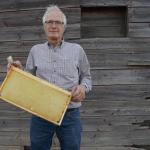Calvin Heinrichs came into beekeeping in the most unusual way.
A swarm of bees settled under one of the houses on the family farm. While researching ways to get the hive to leave, he became rather enamoured with the insect.
Calvin now has three hives, in which 60,000 honeybees live per hive. He tells me this constitutes a very small apiary.
“I’m somewhat new to beekeeping,” says Heinrichs. “I only started this three years ago after taking a very helpful beekeeping course by Alberta Agriculture. I like to think that if I can become a beekeeper, everyone can do it.”
A retired City of Calgary employee, Heinrichs and his wife Reida now manage her family’s century-old family farm. Located in Rocky View County, they grow canola, alfalfa and wheat. They also raise 35 head of beef. Bees, however, hold a special place in Calvin’s heart.
“Bees are fascinating creatures,” he says. “The more you learn about them, the more amazing they become. For example, they build, or draw, honeycomb cells on an angle so as not to allow the honey to drip out.”
Before I arrived, Calvin had removed some frames from his hives. Sure enough, the combs were angled slightly upwards. Each honeycomb had been sealed by the bees with a whitish-coloured wax cap.
“Bees only cap the honey once it has reached the correct moisture content,” explains Calvin. “They place nectar in the honeycomb cell and leave it uncapped to allow some of the water to evaporate, and fan their wings over the cell to speed the process along. It’s quite impressive.”
In order to collect the honey, Calvin must remove this wax cap using a hot electric plane. This beeswax can be used to make items such as candles, lotions, balms and polishes.
The frames then go into the honey extractor, a simple device that uses centrifugal force to remove the honey without destroying the comb.
Bees draw the comb and wax cap by scraping a waxy scale off of their abdomens. They then add saliva to the scale to make it malleable. It’s a labour-intensive process which is why keeping the comb intact is important – it allows the bees to focus on making honey.
With the honey now dripping from the extractor and into a bucket, it’s time to taste the final product. Depending on the flowers they have visited, honey flavours can vary wildly. Having likely gathered nectar from Calvin’s canola, alfalfa and sanfoin fields, his bees produce honey that is light and fragrant. It is much lighter than the standard supermarket honey.
Calvin packages the honey in 1-kilogram and 3-kilogram jars which he sells from his home. Considering the average worker bee produces only about 1/12th teaspoon of honey in her lifetime, it’s safe to say a lot of work has gone into each honey jar.

Many of the foods we eat on a daily basis require the help of pollinators to produce. Pollinators include birds, bats, butterflies, moths, flies, beetles, wasps, small mammals, and most importantly, bees. As they visit flowers in search of nectar, they transport pollen grains from the male anther of a flower to the female stigma.
Some of the most common foods that require pollination include apples, blueberries, chocolate, coffee, melons, peaches,
potatoes, pumpkins, vanilla and almonds.

Colonies:
Honeybees live in colonies. These days, most bees live in manmade hives made up of boxes, placed atop one another. Wood frames are placed in these boxes. Frames usually include a plastic honeycomb foundation on which the worker bees can quickly and neatly build the comb.
The queen bee:
The queen is the largest bee in the colony. A larvae becomes a queen bee when it is given “royal jelly,” a secretion from the glands on the heads of young worker
bees. She emerges from her comb and mates with drone male bees whereupon she collects the sperm that will last her the rest of her two- to five-year life. Her sole purpose is to lay eggs – approximately 3,000 per day.

Drones:
Male bees are called drones. They do not have a stinger. Their main function is to be ready to mate with a queen bee.
Worker bees:
Non-reproducing female bees are called worker bees. The duties they perform vary according to their age. Worker bees keep the hive running smoothly by feeding the queen and larvae, producing wax comb, protecting the hive entrance and keeping the hive cool by fanning their wings. As they get older they collect pollen and nectar for the hive. Worker bees are the smallest in the colony. During the busy season (spring and summer), their lifespan is about six weeks.








